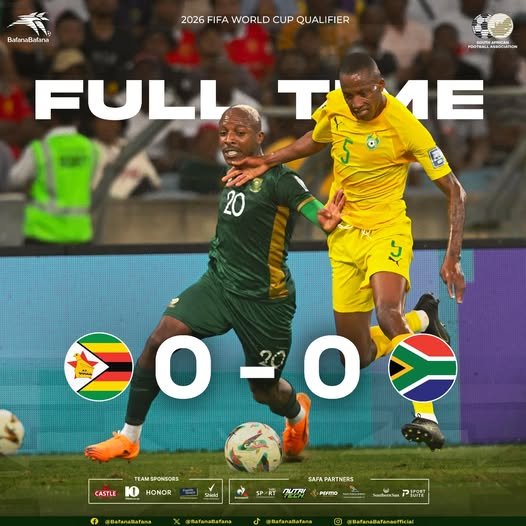How Zimbabwe’s Defence and Smart Substitutions Silenced Bafana in Durban
When the Warriors walked into Durban’s Moses Mabhida Stadium on Friday night, few believed they could hold 2026 World Cup hopefuls South Africa. Ninety minutes later, Michael Nees’ men had not only survived — they had out-thought, out-fought, and out-disciplined one of Africa’s most in-form sides.
This was not a draw of luck. It was a masterclass in tactical structure, defensive bravery, and smart in-game management.
Defensive Wall Rebuilt
Facing a side known for pace and sharp combination play, Nees reshaped his entire backline. Out went the regular fullbacks, and in came Munashe Garananga, a tall, disciplined defender who was deployed at right back to counter Orlando Pirates’ livewire Oswin Appolis.
Alongside him, Gerald Takwara and Teenage Hadebe anchored the centre with authority, while Divine Lunga manned the left channel — a quartet that combined height, timing, and discipline.
Nees’ tactical tweak paid off: Zimbabwe restricted Bafana to half-chances and forced them to play wide, away from their central comfort zone.
“We knew they thrive through the middle, not with crosses,” said veteran goalkeeper Washington Arubi.
“So we closed the centre and invited them to go wide. Once they crossed, we dealt with everything.”
The statistics back it up — 14 clearances from Hadebe, 7 from Takwara, and 4 from Lunga, including his heroic goal-line clearance.
Musona’s Involvement and Tactical Rotation
Before his sending off, Knowledge Musona did far more than lead the line. Whenever South Africa overloaded one flank, he dropped deep to double up in defence. On the opposite side, Jordan Zemura tracked back to cover Lunga, turning Zimbabwe’s shape into a fluid 4-5-1 when out of possession.
Meanwhile, Khama Billiat, Marshall Munetsi, and Marvelous Nakamba provided relentless midfield coverage — alternating between pressing and shielding the back four. It wasn’t glamorous, but it was effective.
Substitutions that Changed the Rhythm
When Zimbabwe went down to ten men, Nees reacted quickly — not defensively, but intelligently. He introduced Tawanda Maswanhise, Emmanuel Jalai, and Bill Antonio to restore energy and keep Bafana from settling into dominance.
Maswanhise’s fearlessness on the right immediately unsettled South Africa’s defence. His pressing and pace pinned back Mbokazi, who eventually lost his composure and earned a red card after clashing with the young winger.
That moment symbolised Zimbabwe’s night: discipline and intelligence overcoming pressure and chaos.
Warriors’ New Identity
For a team long criticised for inconsistency, this display showed a growing sense of unity and tactical awareness.
“We had nothing but pride to play for,” said Munetsi, “but we wanted to show we can compete — and we did.”
Even under numerical disadvantage, the Warriors held firm, nearly snatching victory late on when Zemura’s curling effort struck the post.
Nees called the match “a stress test” — and his team passed it with distinction.
Looking Ahead
The Warriors now travel to Polokwane for their final Group C fixture against Lesotho. Though both sides are out of World Cup contention, Nees sees this as another step in his AFCON 2025 build-up.
Friday’s goalless draw wasn’t just a result — it was a statement: Zimbabwe can defend, adapt, and believe again.

